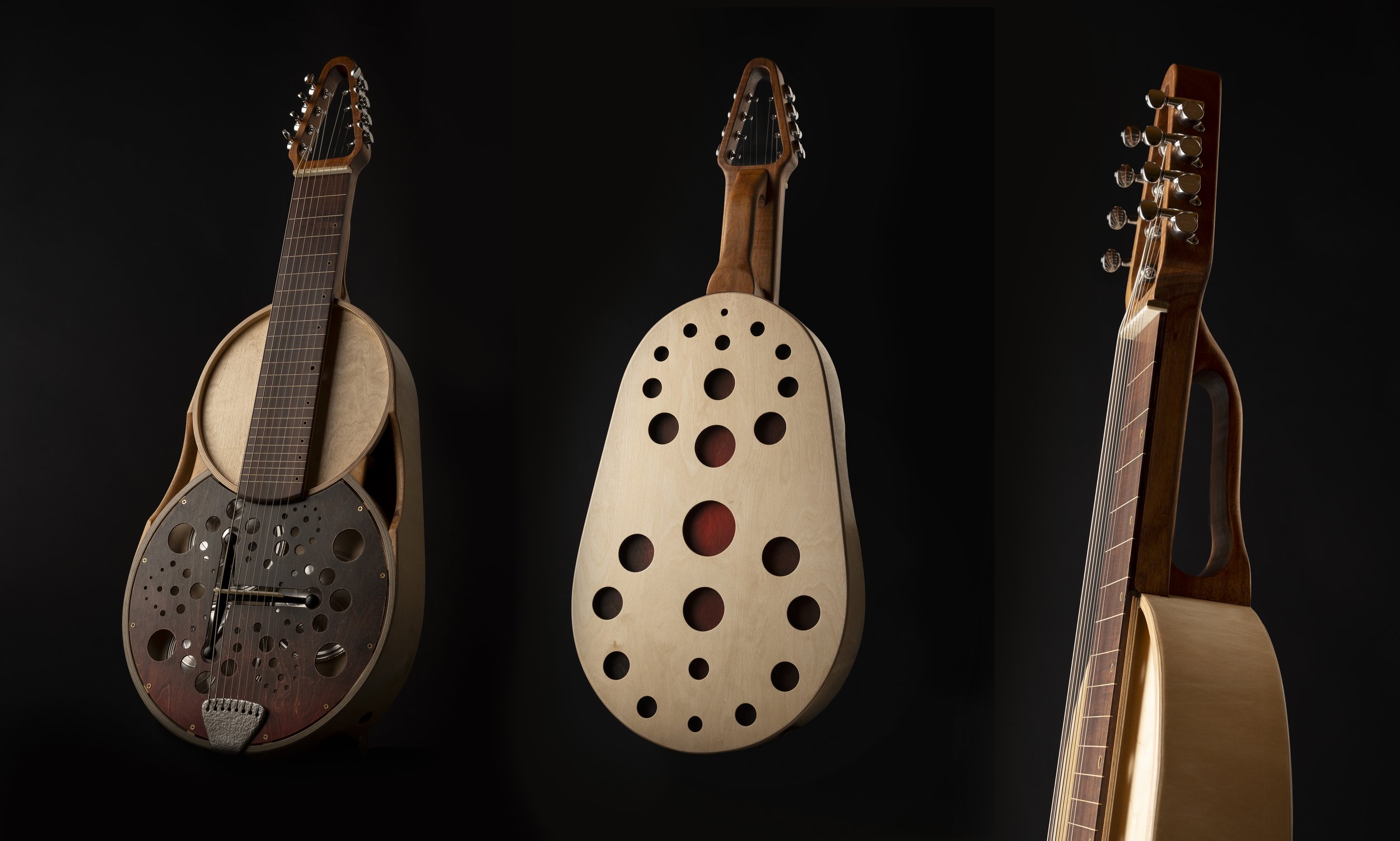The Super Dynamic Resophonic 3.8
Triptych of the unique SDR 3.8, Wistow, SA Jan 2025 - photos by the luthier, Andy Rasheed.
For the last decade, I’ve been visiting Adelaide Hills artisan, photographer and musician, Andy Rasheed. On each of these sojourns, I’d investigate his latest experiments with musical instruments, notably his unorthodox and innovative acoustic steel guitars. Each time there’d be a new angle, a different way of approaching the bold voice of conventional resonator guitars. His idea is universal - converting the energy of a vibrating string into the highest excitment of air molecules possible. Doing this acoustically has and will likely always have limitations. Richard Wagner, for instance, felt this during his career and bolstered the members of his orchestras towards a hundred members - with dramatic results, but the amplication factor of a lone acoustic instrument will always hit a wall at some point. Trumpets are pretty loud… pipe organs are much louder - but the guitar, outside of its electrical cohort, remains a tad hamstrung. The physics dictate this. The old-time resonator guitars were born out of this dilemma and in the process, a stonking, metallic voice we’ve come to associate with blues and rootsy stylings, carved out a particular niche, along with scores of visionary players. >>>> Halfway through 2024, Andy had me try out a tri-cone design he’d been developing and straight away, I knew it was right for me. I suppose it was the warmer tone and closer resemblance to a regular acoustic guitar timbre, but as a musician certain things speak to you. It’s all about hearing the potential. So I went away and thought about it for a fortnight. Andy’s instruments had all been 25.5” scale, the same as most Fender guitars. I realised I wanted familiarity tempered with challenge. To that end, (and with a little consultation from peers with sacred knowledge and others in possession of sacred talismans) I came back at Andy with this: A 24” scale, 8 strings, a 70 to 77mm string spacing borrowed from my 1963 Maton Slivertone double-neck steel, all this tuned up to a taut open E chord with extension notes on either side of the standard 6 string arrangement. The depth of the body was to taper from the tail back up towards the neck. This would throw a new set of unique specifications onto an already highly individual design. A few months later and a Christmas/New Year spell in SA later, the end result is a thing to behold. Acoustically, it barks like a freshly washed blue heeler. It should be noted that the back of the instrument has a braced soundboard overlaid with a perforated back plate that allows all the acoustic surfaces to vibrate freely. A normal acoustic lap-steel has it’s back deadened by default. Not so with the SDR 3.8. Aircraft-grade birch ply is incorporated throughout, New Guinean rosewood for the neck and gorgeous plank of arcacia forms the fretboard, the lines for intonation being slivers of sycamore. I embarked on a solid research program to determine what pickups I will add to this machine and thus bring it to a stage-ready state. Anyone who has tried to amplify resonator guitars will know how much of a challenge this can be, but I think I’m ready to proceed with a combination of magnetic, microphonic and piezo contact type transducers. The ordering of components from several corners of the globe is underway with the covid-transformed, global-shipping phenomena doing it’s best to slow it all up. Watch this space. >>>> This is my second custom-ordered guitar, the first being an indiviually-specced Maton Mastersound electric 6-stringer during that brief but fun-filled early salvo of Country Rock ‘n’ Roll from the Re-mains. The name SDR 3.8 was settled on after realising that more suitable monikers, “The Dominator”, “The Growler” and “The Punisher” were already taken. Andy’s company is called Small Drum Revolution. I reasoned this could also be an acronym for “Super Dynamic Resophonic”. Pinching domestic sound-system coding and applying a “3” for the number of resonator cones and an “8” for the number of strings filled out the label. I’ll write another entry when the instrument is fully kitted up with it’s compliment of 5 pickups. >>>> Until then, take a look at this interview Andy shot with me just after I took the guitar away. Also linked are the relevant pages for Small Drum Revolution and the other various activities of a maker who truly cares about his craft and who deserves to be given custom. Thank you Andy. There is more to come.
